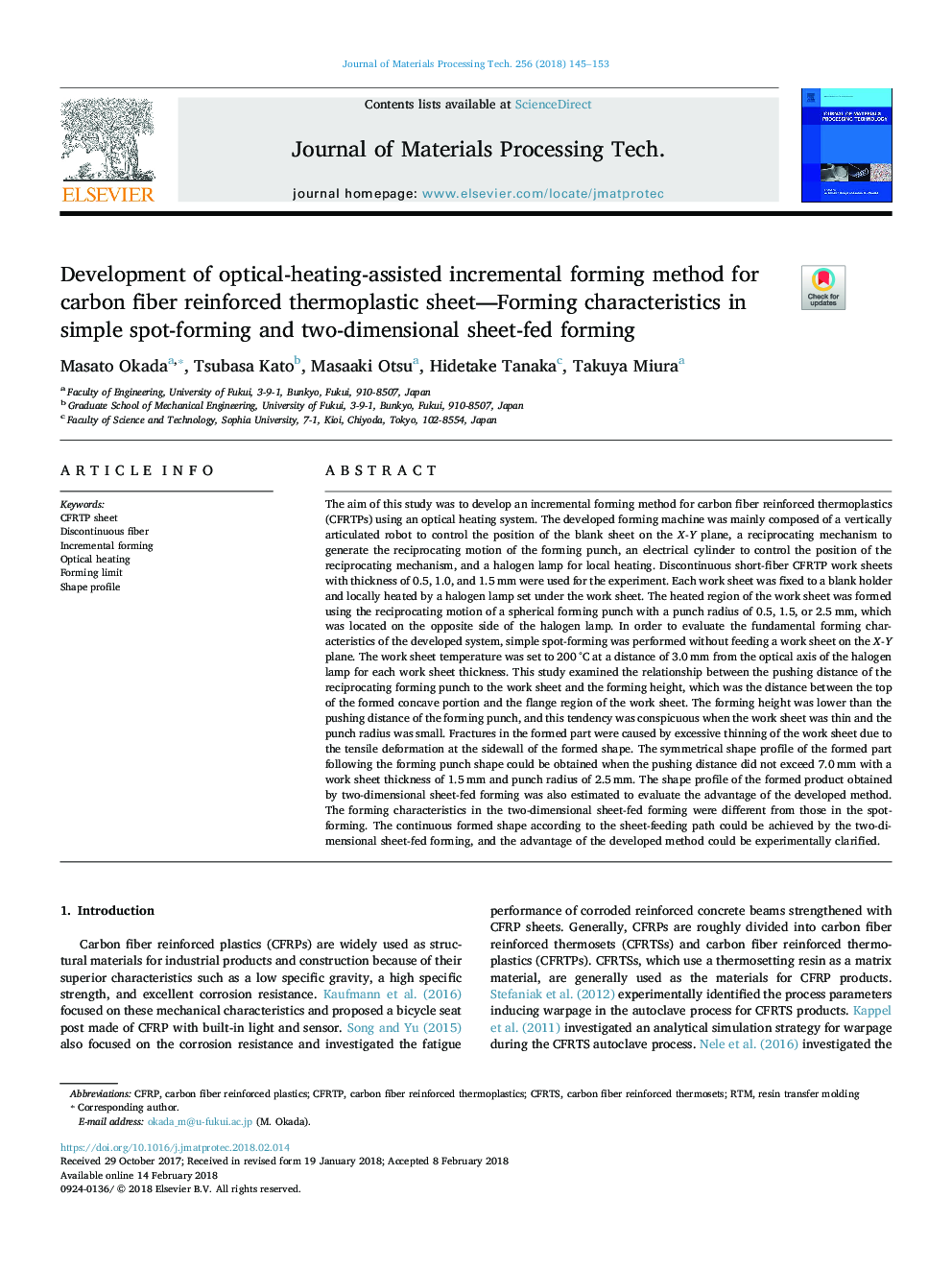| کد مقاله | کد نشریه | سال انتشار | مقاله انگلیسی | نسخه تمام متن |
|---|---|---|---|---|
| 7176398 | 1466711 | 2018 | 9 صفحه PDF | دانلود رایگان |
عنوان انگلیسی مقاله ISI
Development of optical-heating-assisted incremental forming method for carbon fiber reinforced thermoplastic sheet-Forming characteristics in simple spot-forming and two-dimensional sheet-fed forming
ترجمه فارسی عنوان
توسعه روش تهیه نوری گرمایی با کمک حرارت برای ورق های ترموپلاستی تقویت شده با فیبر کربن- ویژگی های تشکیل در شکل گیری ساده و دو بعدی ورق تغذیه
دانلود مقاله + سفارش ترجمه
دانلود مقاله ISI انگلیسی
رایگان برای ایرانیان
کلمات کلیدی
موضوعات مرتبط
مهندسی و علوم پایه
سایر رشته های مهندسی
مهندسی صنعتی و تولید
چکیده انگلیسی
The aim of this study was to develop an incremental forming method for carbon fiber reinforced thermoplastics (CFRTPs) using an optical heating system. The developed forming machine was mainly composed of a vertically articulated robot to control the position of the blank sheet on the X-Y plane, a reciprocating mechanism to generate the reciprocating motion of the forming punch, an electrical cylinder to control the position of the reciprocating mechanism, and a halogen lamp for local heating. Discontinuous short-fiber CFRTP work sheets with thickness of 0.5, 1.0, and 1.5â¯mm were used for the experiment. Each work sheet was fixed to a blank holder and locally heated by a halogen lamp set under the work sheet. The heated region of the work sheet was formed using the reciprocating motion of a spherical forming punch with a punch radius of 0.5, 1.5, or 2.5â¯mm, which was located on the opposite side of the halogen lamp. In order to evaluate the fundamental forming characteristics of the developed system, simple spot-forming was performed without feeding a work sheet on the X-Y plane. The work sheet temperature was set to 200â¯Â°C at a distance of 3.0â¯mm from the optical axis of the halogen lamp for each work sheet thickness. This study examined the relationship between the pushing distance of the reciprocating forming punch to the work sheet and the forming height, which was the distance between the top of the formed concave portion and the flange region of the work sheet. The forming height was lower than the pushing distance of the forming punch, and this tendency was conspicuous when the work sheet was thin and the punch radius was small. Fractures in the formed part were caused by excessive thinning of the work sheet due to the tensile deformation at the sidewall of the formed shape. The symmetrical shape profile of the formed part following the forming punch shape could be obtained when the pushing distance did not exceed 7.0â¯mm with a work sheet thickness of 1.5â¯mm and punch radius of 2.5â¯mm. The shape profile of the formed product obtained by two-dimensional sheet-fed forming was also estimated to evaluate the advantage of the developed method. The forming characteristics in the two-dimensional sheet-fed forming were different from those in the spot-forming. The continuous formed shape according to the sheet-feeding path could be achieved by the two-dimensional sheet-fed forming, and the advantage of the developed method could be experimentally clarified.
ناشر
Database: Elsevier - ScienceDirect (ساینس دایرکت)
Journal: Journal of Materials Processing Technology - Volume 256, June 2018, Pages 145-153
Journal: Journal of Materials Processing Technology - Volume 256, June 2018, Pages 145-153
نویسندگان
Masato Okada, Tsubasa Kato, Masaaki Otsu, Hidetake Tanaka, Takuya Miura,
